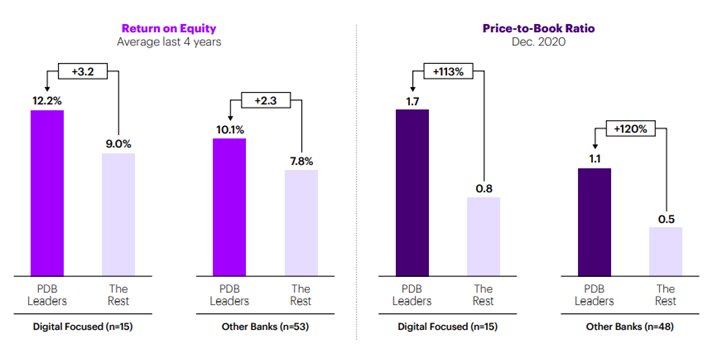Other parts of this series:
It’s an axiom among data-minded people that “In God we trust; all others must bring data.” Today we’re going to apply that idea to the hypothesis that purpose-driven banks outperform their peers.
The specific data we’re looking at comes from Accenture research on the subject, which analysed 70 leading banks from around the world using three different lenses: customers, employees and products.
- The Customer Lens looks at whether customers trust banks to look after their financial wellbeing and to deliver service that is personalized, efficient and empathetic.
- The Employee Lens considers whether employees feel engaged with the bank’s culture and values and whether the workplace is fair, diverse, and helps employees improve their skills.
- The Product Lens examines whether a bank’s products are simple, fair and transparent, and whether its mobile app offers effective personal financial management and wellness tools.
We chose these areas of focus because they allow us to see how different aspects of embracing purpose impacts a bank’s profitability, customer trust, and market position.
We evaluated five different indicators for each lens—for instance, we drew on customer retention rates and reasons for switching from Accenture’s Global Banking Consumer Study for the Customer Lens—to create a score out of 100. Then we took the simple average of all three lens scores to create a bank’s Purpose-Driven Banking Intensity Scale score.
Finally, the banks that scored in the top 25% on the Intensity Scale—we call them the Purpose-Driven Banking Leaders, or PDBLs—were compared with the rest of the banks in our sample in terms of their financial performance.
It pays to have purpose
The headline takeaway from our analysis is that the biggest winners in the industry right now—and those best positioned to take advantage of an “electric car moment” in the industry—are digitally mature banks that are embracing purpose. They show the best return on equity over the last four years and the best price-to-book ratio.
Figure 1. Banks that are both digitally focused and purpose-driven achieve the best financial performance

Merging these results with data from other Accenture banking research produces some powerful insights. When we map the results of our Digital Maturity research to the PDB Intensity Scale, we find the highest ROE and P/B ratios among banks that excel on both dimensions.
In other words, embracing purpose is one of the keys to maximizing the return on digital transformation investments. And while banks that are purpose-driven and digitally mature achieve the best performance, it appears that being purpose-driven is more important than being digitally mature, assuming a base level of digital capability.
Innovative banks, acting with purpose
So, what does this fusion of digital fluency and purpose look like right now?
It looks like DBS, the Singapore bank that uses AI to forecast individual customers’ financial status at retirement age, and a Map Your Money program to help them optimize that status. It has also partnered with Chubb to offer all its customers one month’s free insurance against Covid-19-related ailments.
It looks like ANZ creating a financial wellbeing program for customers. The program includes a six-week email course that offers coaching, knowledge, tips and tools to boost financial fitness. It has reached over 725,000 customers.
And it looks like Bank of America launching Life Plan, a digital tool that helps customers set and track near- and long-term financial goals. Life Plan attracted 2.3 million users last year.

Purpose-Driven Banking 2021 report – driving powerful transformation for banks.
Learn moreCommon weak spots and common challenges
Our Purpose Intensity Scale also reveals that virtually all banks, including PDBLs, are weak in two areas.
The first is mobile apps. Our assessment concluded that virtually every bank could do much more to add features to its app that address customer needs and help them better manage their finances. Out of a list of more than 40 best-in-class mobile app features that we believe are important in enabling customers to better manage their finances, banks have on average only 40% of these features. And when it comes to debt prevention and management, 54% of the banks surveyed offered nothing specific in their apps to assist customers.
The second common weakness was trust. Accenture’s most recent Global Consumer Banking Study found that in 2020, only 29% of customers trust their banks “a lot” to look after their long-term financial wellbeing—down sharply from 43% in 2019.
These findings line up with our Empathetic Banking Survey, which found that just three in 10 banks are very confident they can sense a customer’s emotional state without directly asking.
More alarming still is the slow progress of banking’s overall purpose-driven journey. Despite mounting evidence that embracing purpose can drive superior results, only a few banks have taken radical steps in this direction.
Which is why, in our next post, we’ll take a close look at one bank’s journey to put purpose at the heart of everything it does.
To learn more about our latest report on purpose-driven banking visit the Accenture website.
Read report
With thanks to Mauro Centonze and Edwin VanderOuderaa for their contributions to this article.









